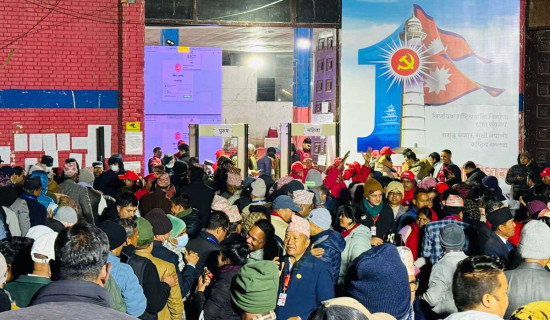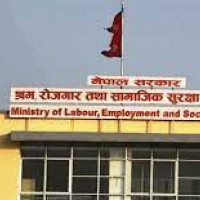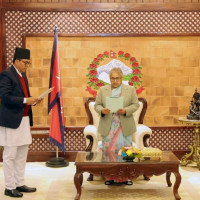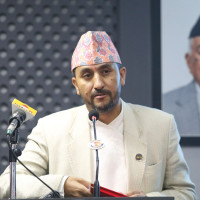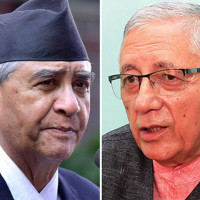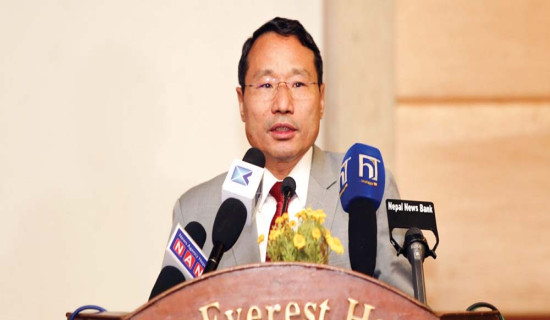- Tuesday, 16 December 2025
Season Of Delightful Family Reunion
For the children's lot, the most thrill-filled moments were on the days before the main events of the Dashain festival started with the ritual ushering in of the Phulpati in homes and temples. Just as the skies cleared with the retiring of the monsoon and festive flowers starting to bloom, a new wave of joy would flow in the air for all. They said that the festival is mainly meant for the children while for the elders, it is about financial concerns. The older generation called Dashain a Dasha or ill fate. We children were least bothered about the worries of the parents. There was an unprecedented surge of energy and a deep sense of merriment. Caring little about sweat and tiredness, the whole lot of children in the village joined hands to dig and repair the roads and trails to welcome the great festival.
"You should construct the way nicely, so the festival can march along up to your doorsteps soon," they encouraged us to get ourselves engaged in cleaning and trail repair. Our list of festive preparations included cleaning, road repairing, collecting extra piles of cattle fodder, decorating the walls of homes and installing Rote Ping and Linge Ping for jolly swinging throughout the festival.
A series of cultural events in the lunar calendar came as the messenger to herald the approaching of the great celebrations of the year. First came the Sohra Shraddha rituals performed over 16 days to pay homage to the deceased parents and grandparents. The Shraddha rituals have to precede the worshipping of gods and goddesses because the two rituals cannot be performed together. Memorial respects for the deceased, hence, are paid before the start of the season of worshipping and prayers of the power goddesses, which begin from the day of Ghatasthapana.
Ghatasthapana is the day from which the mirthful spirit of the Dashain festival starts in earnest along with the sowing of the corn and barley seeds in the pure soil inside the sacred worshipping spots for producing the famous Jamara sprouts. In the sacred corner of every household the seeds germinate and grow into yellow and tender shoots that are used as flowers to offer to the goddess and the people who visit senior relatives to receive Tika blessings. Worshipping of the power goddess Nava Durga begins on the day of Ghatasthapana and continues for nine days until it culminates on the tenth day, known as Bijaya Dashami or Tika. This period is known as Nava Ratri, or nine nights, during which nine different incarnations of the goddess Durga Bhawani are worshipped.
In Kathmandu, observing the weeklong Indrajatra festival indicates that the Dashain festival is not far away. Within days from the conclusion of this jatra, which features chariot processions of Ganesh, Bhairab and Kumari and attended by the heads of the nation, government and other high-level dignitaries, the nine nights of Durga prayer rituals begin.
With the monsoon receding, cloudy and rainy days are generally over and they are sunny and bright during the festival season. These seasonal features are sometimes different, as the festival takes place relatively earlier every three years, known as Adhik Mas due to lunar and solar calendar adjustments. There is a popular saying in Nepal that if the Sohra Shraddha period is dry, the Naba Ratri period will be wet and cloudy and vice versa. This year, the Dashain festival is taking place relatively earlier, with the Ghatasthapana falling on September 22. Compared to last year, this year's Dashain festival is taking place 12 days earlier. This shift is applicable also in the observance of other major festivals, including the Tihar and Chhath.
Travelling decades back, we used to have 15 days of Dashain holiday in school, providing us enough time for making festive preparations. We were not overloaded with homework projects, though there used to be extra work for the half-month break. Young people took the lead when it came to installing Ping or swings.
Rote Ping, framed out of heavy Sal logs and branches, used to be set up in the middle of the village, where people of all ages gathered to enjoy the traditional merry-go-round-style swing.
Under the open sky lit by the waxing moon, folk songs echoed in the air to the tune of the Madal drum while the Rote Ping kept gyrating with grinding noise not-stop throughout the night. Even those who decided to stay home would not be able to sleep without joining this nighttime celebration. People from different communities came to celebrate together. This was a unique opportunity to get to know each other better. There were apparently two communities of people in the village – those who could publicly have alcoholic drinks and those who could not. But all of them sat together, sang, played the madal, danced and enjoyed swinging. Those who could not be offered Raksi drinks would be offered cigarettes.
In addition to the main Rote Ping in the central spot of the village, Linge Ping or rope swings were built in different parts of the village, to be played during the day. Young people of the village used to work hard to collect the Babiyo grass and weave the massive ropes that had to be strong enough to withstand the weight of the swingers.
While the children and teenagers were gripped by the thrill of celebrations, however, elders in-charge of the families would be under the spell of financial worries. Those without cash income would find it difficult to manage the celebrations as they had to make urgent purchases of new clothes, meat and spices. Failure to buy new clothes for children would amount to humiliation for the family in the society. Following the tiresome toils in the farms or foreign soil, it was the time for rejuvenation of energy with the best festive food which inevitably consisted of meat. Preparing the festive meat cuisine called for the purchase of associated items like cooking oil and spices.
Unless one was in a position to earn a salary or have some surplus commodities such as agro products and livestock to sell, he was cash-strapped and had to approach the money lender. There were some people in the village whose festive borrowings had landed them in India to work as a Darban (doorman) to guard homes and offices of merchants there. Such workers would come home for the festival with some income to manage the celebrations and to pay back the debt. Time has changed but the cultural and social essence of Dashain has not. The festival pulls people from their workplaces to their ancestral homes, be it within the country or outside. Even those who have settled abroad participate in Dashain celebrations in the same spirit of mirth and merriment. Now is the season of great family reunions of the year. Dashain stands out as the greatest cultural vehicle to bring home kith and kin for a long-cherished get-together.
(The author is the former editor-in-chief of The Rising Nepal.)



